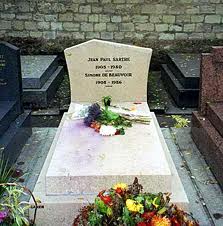Existentialism And Mysticism continued
Jan. ’78
As Douglas Hofstadter might say, I’m jumping out of the system—errr jumping out of my story. In the next few sentences I’m going to structure the philosophies of Sartre and Nishitani in terms of symbolism — a symbolic structure of reality, life, and reason. I’m jumping out of my story here because I believe that this post (on Sartre and Nishitani) and tomorrows post (on Nishitani) achieve a descriptive quality (in terms of vocabulary) that comes as close as one can come to putting labels on the symbols that represent, for me, reality, life, and reason. I apologize if I am mudding up the waters here, but I feel compelled to do this: Let ~~b, or being-what-is-not-while-not-being-what-is, represent reality. Reality grows in complexity until it becomes full of life, in other words, ~~b reality, liberates ~bb, i.e., life. This complexity process moves forward. Reality and life, at a sufficient level of complexity, liberates reason. At this level, the structure b~b~bb liberates what we call “civilization” while remaining embedded in life and reality. Bottom line here is that when Nishitani is talking about sunyata he is talking about the reality of being-what-is-not-while-not-being-what-is. But, when Sartre says that “the human project, suspended in nothingness, projects the self ceaselessly outside of itself,” he is talking about the ~bb structure of b~b~bb (the other part of the structure, the b~b part of b~b~bb represents the physical event—or the empirical world used to confirm scientific experiments). In other words, Nishitani’s sunyata is not inconsistent with Sartre’s pre-reflected cogito, or the ego/nothingness that condemns man/woman to freedom; Nishitani and Sartre are both talking about the same thing, i.e., Nishitani’s sunyata, at the level of “reason liberated” and Sartre’s Being And Nothingness.
Existentialism And Mysticism continued:
Sartre believed that his theory was the only theory truly compatible
with the dignity of man because his theory didn’t turn man into an
object. However, according to Nishitani, the problem with that belief
was that no matter how much the self’s subjectivity got stressed, as
long as the “cogito” maintained the standpoint of self-consciousness,
there would always be a tendency to turn the self into an object.
“Moreover,” says Nishitani, “even though Sartre’s theory appears to
preserve the dignity of man in his subjective autonomy and freedom,
the real dignity of man seems to me to belong only to one who has been
`reborn,’ only in the `new man’ that emerges in us when we are born by
dying, when we break through nihility.” Nishitani is speaking from a
Buddhist perspective, which understands sunyata (nothingness,
emptiness) as non-ego.
The nothingness at the bottom of the self (for-itself) is not
sunyata because sunyata is not the ground of the subject. The
nothingness bound self of Sartre may be fundamentally deepened, but as
long as it makes itself present as an object of consciousness, it
remains a kind of being, a kind of object. To see nothingness in that
way is to see the self as having no ground to stand on. But, says
Nishitani, — “the nothingness that means `there is no ground’ (the
nothingness of Sartre’s for-itself) positions itself like a wall to
block one’s path and turns itself into a kind of ground, so we can
still say that `there is a ground.’ However, only absolute emptiness
is the true no-ground (Ungrund). Only from the perspective of absolute
emptiness is the flower, stone, stellar nebulae, galactic systems, and
even life and death themselves—present as bottomless realities. True
freedom lies in this no-ground. Sartre’s freedom is still bondage, a
kind of hole that has the ego projected into it like a stake driven
into the ground for the self to be tied to.”– Sartre’s ego then has
more in common with bondage than it does with freedom, or so says
Nishitani, and I agree.
Absolute nothingness, as opposed to Sartre’s negative nothingness at
the center of self-consciousness, is the source of real freedom. This
nothingness, sunyata, took center stage in Nishitani’s book Religion
and Nothingness, and according to Nishitani (and here I will let him
speak for himself), before we can understand sunyata we must
understand that nihilty is not sunyata:
“Nihility is an absolute negation aimed at all ‘existence,’ and thus is
related to existence. The essence of nihility consists in a purely
negative (antipodal) negativity. Its standpoint contains the
self-contradiction that it can neither abide in existence nor abide
being away from it. It, nihility, is a standpoint torn in two from within.
Therein lies its transitional character. We call it the standpoint of
nihility, but in fact it is not a field one can stand on in the proper
sense of the term. It is no more than a spot we have to ‘run quickly
across’….the standpoint of sunyata is another thing altogether. It is
not a standpoint of simply negative negativity. It is the standpoint at which
absolute negation is at the same time, in the sense explained above, a
Great Affirmation. It, sunyata, is not a standpoint that only states that the
self and things are empty. The foundations of the standpoint of
sunyata lie elsewhere: not that the self is empty, but that emptiness is the self;
not that things are empty, but that emptiness is things. Once this conversion
has taken place, we are able to pass beyond the standpoint on which
nihility is seen as the far side that is beyond us (the Buddhist idea
of the ‘yonder shore’ of the sea of samsaric suffering), but a far
side that we have arrived at.” (Paraphrased from Religion and Nothingness p.137)




At the quantum level, solutions to problems become entangled in “uncertainty relationships”–a consequence of “emptiness is things”. Evolution, at the quantum level, is not just associated with biology (the observer generated event); it is also associated with structure, the structure that embeds observer, observation, and the logic that predicts events.